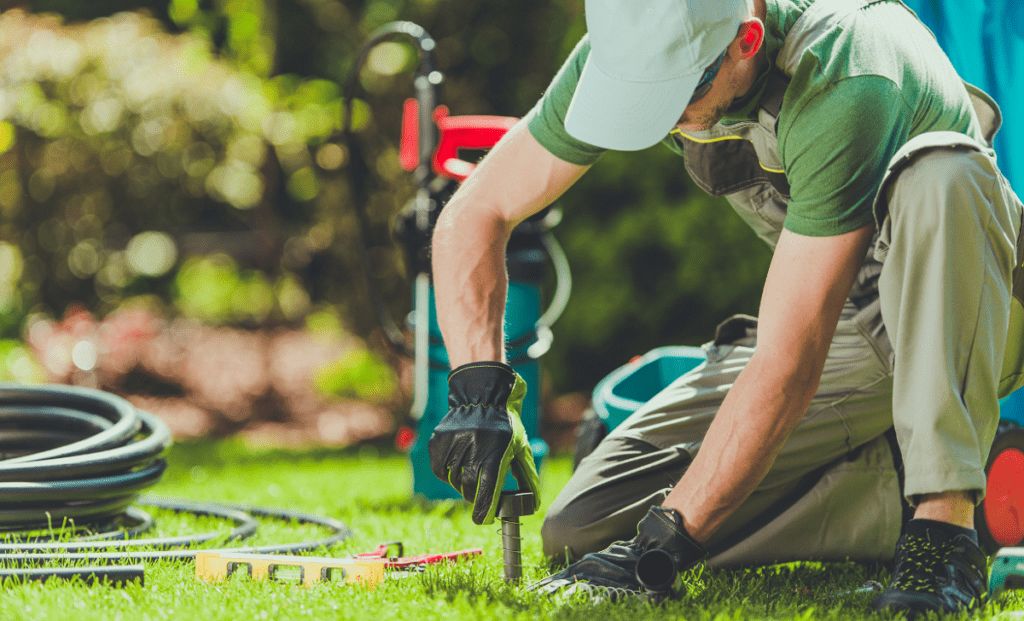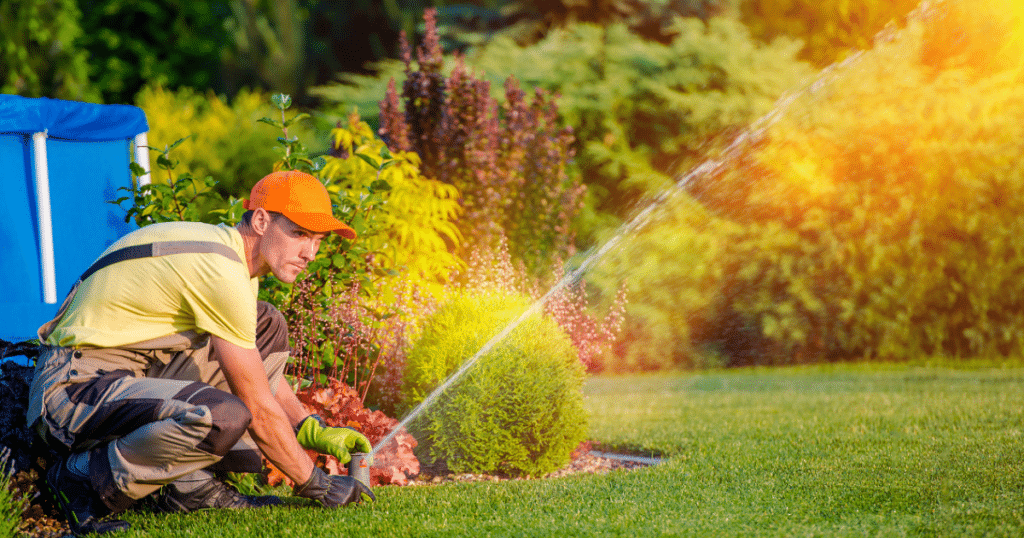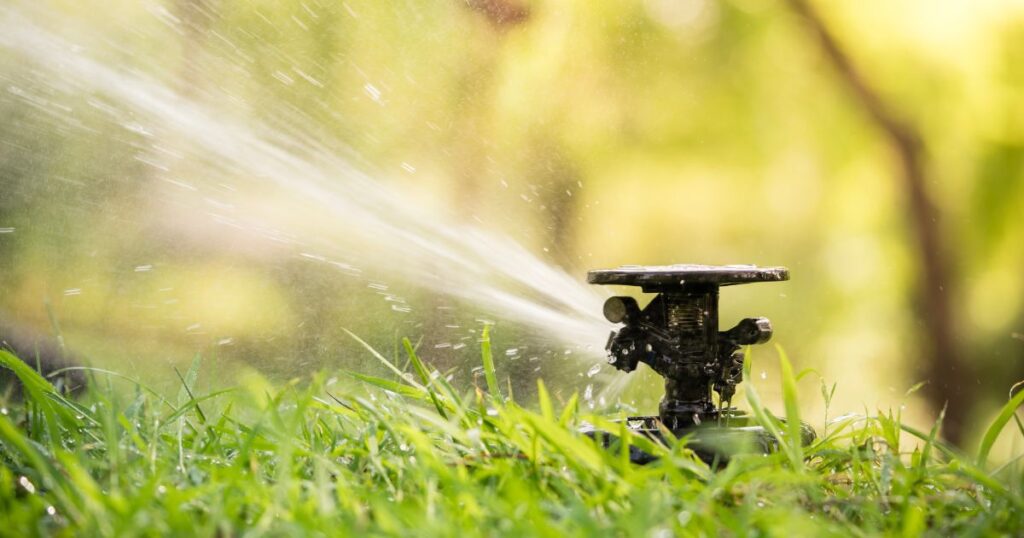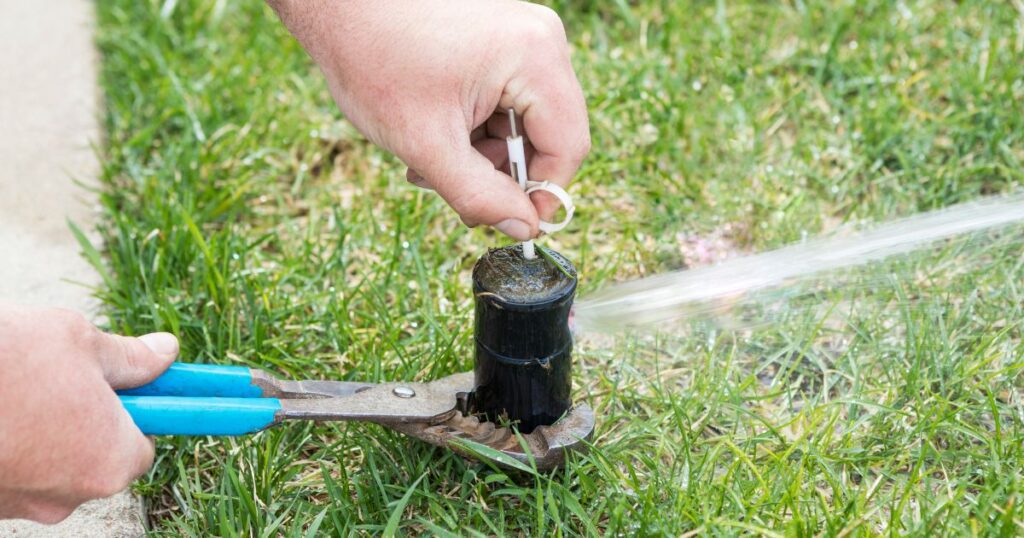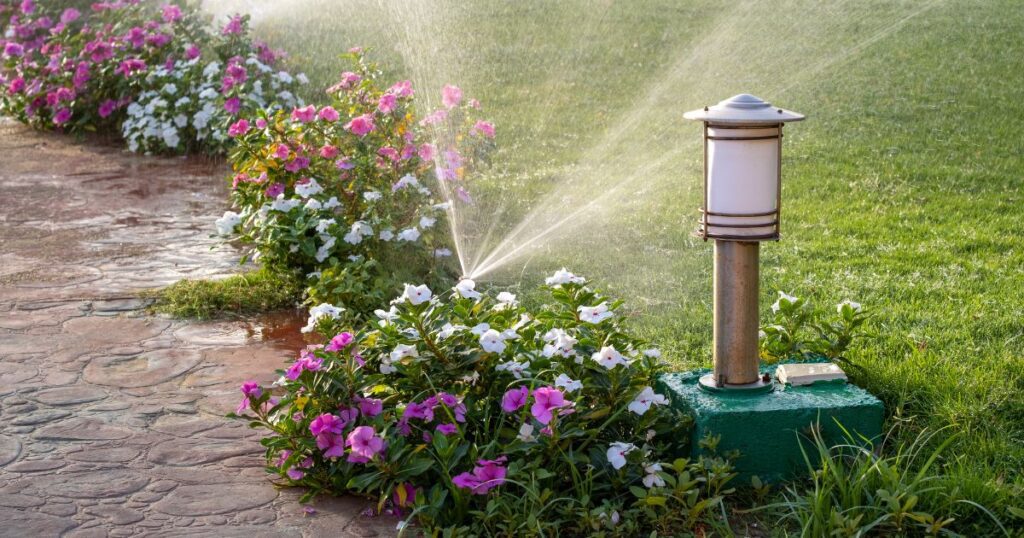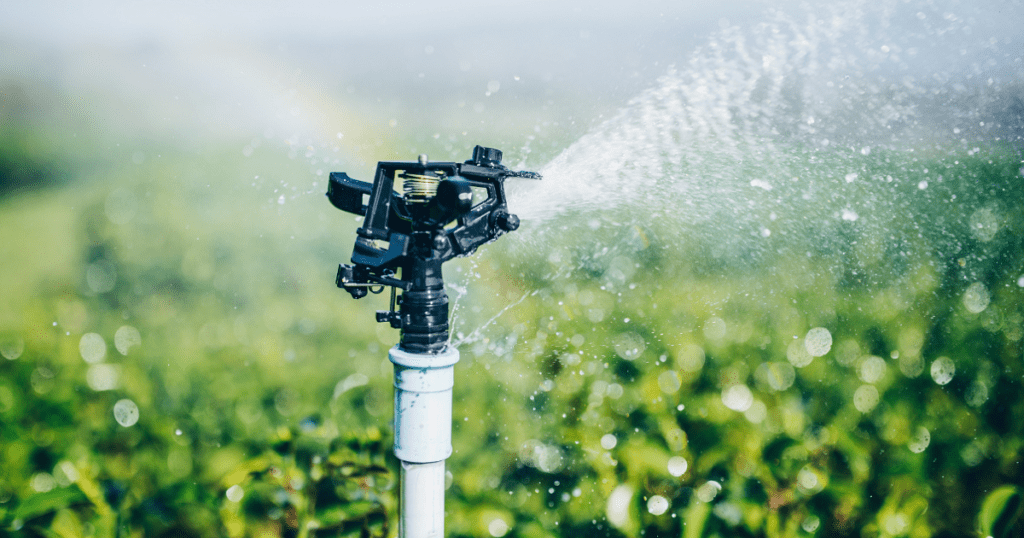
Defining the Sprinkler System
A sprinkler system is an irrigation system that uses pipes, valves, and sprinkler heads to distribute water evenly across a designated area. These systems are commonly used for watering lawns, gardens, and other landscapes. They are typically set up with a timer or automated controller to ensure consistent watering according to the needs of the area being irrigated.
The Importance of Maintaining a Functioning Sprinkler System
Maintaining a functioning sprinkler system is crucial for ensuring that your lawn and garden receive the appropriate amount of water. A broken or malfunctioning system can lead to overwatering, underwatering, or uneven watering, which can negatively impact the health and appearance of your landscape.
Additionally, investing in regular maintenance and repairs can help you save money in the long run by avoiding costly replacements that may be necessary if neglected issues persist. Proper upkeep also helps conserve water which not only benefits your wallet but also helps preserve this valuable resource.
Overview of the Topic
This comprehensive guide will cover all aspects of sprinkler repair and maintenance, including common problems experienced by homeowners, tools, and materials needed for repair work, troubleshooting techniques for identifying problems with your system, safety precautions when working on sprinklers, and tips for preventive maintenance. Whether you are looking to upgrade your existing automatic sprinkler system or simply need guidance on basic repairs like sprinkler head replacement or valve repair – this guide will provide you with everything you need to know to keep your irrigation running smoothly. We will delve into topics such as irrigation repair costs and cost-effective solutions that may be possible depending on your specific situation.
Furthermore, we will discuss commercial sprinkler repair services available in case a more complex issue arises beyond home repairs. It is essential to maintain your sprinkler system through regular upkeep and prompt repairs as needed.
Doing so will contribute to a healthy and thriving landscape while conserving water and saving money in the long run. This comprehensive guide will equip you with everything you need to know to keep your sprinkler system working effectively for years to come.
Common Sprinkler Problems
Broken or Clogged Heads
In any lawn sprinkler system repair, the most common problem homeowners and business owners face is broken or clogged sprinkler heads. This can be caused by a variety of issues, including debris buildup, mower damage, or general wear and tear.
The symptoms of this issue include uneven water distribution, low pressure, and dry spots in the lawn. To fix this issue, you’ll need to first locate the broken or clogged head.
This can be done by turning on your sprinkler system and looking for heads that don’t rotate properly, or that emit little to no water. If you’re dealing with a clog rather than a breakage, use a small tool such as a toothpick to remove any debris inside the head.
For a broken sprinkler head repair job, you’ll want to first remove the old head from its fitting using pliers or a specialized tool called a sprinkler head puller. After removing the old head, replace it with a new one that matches both your sprinkler system parts and its location.
Leaking Valves
The next most common issue in lawn care is leaking valves in your irrigation system. This sort of leak can go unnoticed for long periods before causing significant damage to your landscaping if not repaired quickly enough.
Symptoms may include large puddles around the valve box area when your system is on or an audible hissing sound coming from the valve box even when it isn’t in use. Fixing leaking valves requires emergency sprinkler repair attention as soon as possible since it could cause significant flooding issues down the line if ignored.
Start by locating all valves in your system’s valve box and checking them for signs of leakage or damage, such as cracks around their bases. If necessary, turn off the water to the entire system and then open the valve in question, remove it, and replace it with a new one.
Low Water Pressure
Low water pressure is another common issue in sprinkler system troubleshooting. This issue is usually caused by a variety of factors, such as clogged sprinkler heads or a damaged pump.
Symptoms include weak or dribbling streams of water coming from sprinkler heads or uneven distribution across your lawn. To fix this issue, start by testing your system’s pressure at different points throughout your property using a pressure gauge.
If you find low pressure across all or most of your property, then you may need to call in for a sprinkler pump repair job. However, If you find low pressure only at certain locations in your yard, check those specific sprinkler heads and pipes for any blockages that could be causing the issue.
Tools and Materials Needed for Sprinkler Repair
Basic Tools Needed for Repair Work
If you are planning to repair your sprinkler system, there are some basic tools that you’ll need. These include wrenches, pliers, screwdrivers, and other hand-held tools. It is important to have a variety of sizes for each tool, as different parts of the system may require different sizes.
For example, a larger wrench may be necessary to tighten a PVC fitting on the mainline. Having a well-stocked toolbox will help ensure that you can handle any repairs that come your way.
Specialized Tools Needed for Repair Work
In addition to the basic hand-held tools mentioned above, there are also specialized tools that can come in handy when repairing a sprinkler system. These include sprinkler head pullers and valve keys.
A sprinkler head puller is used to remove broken or damaged sprinkler heads without damaging the surrounding turf or landscaping. A valve key is used to turn on or off valve assemblies in the ground when working on irrigation lines or valves.
Materials Needed for Repair Work
Before starting any repairs on your sprinkler system, it is important to gather all the necessary materials. This includes PVC pipes, glue, fittings, and other parts that may need replacing based on what needs fixing.
If you’re not sure what parts you need for your specific repair job or if they’re available at your local hardware store – consult an expert who specializes in these types of repairs. The most common materials used in residential sprinkler systems are PVC pipes and fittings, which can be found easily at hardware stores nearby as well as online stores.
Using high-quality pipes and fittings will ensure the long-term reliability of your system. It is important also to keep in mind water conservation principles while choosing materials – this means using efficient watering nozzles and drip irrigation systems to keep water usage down.
Tool Maintenance
It’s important to keep your tools clean and in good condition, as dirty or damaged tools can cause more damage than good. Make sure that you clean your tools regularly after use with a damp cloth and store them in a dry, cool place. This will help prevent rust or other forms of corrosion that could damage the tools over time.
For specialized sprinkler repair tools, such as valve keys or sprinkler head pullers, it is important to take extra care when storing them after use – these parts can be easily lost or misplaced. Keeping track of all your repair materials and tools is key to being prepared for any emergency sprinkler repair situations that may arise.
Having the right tools and materials for sprinkler repair work is essential for any homeowner who wants to maintain their lawn’s health with a reliable sprinkler system. With the right set of hand-held and specialized tools at hand, alongside quality PVC pipes, fittings, glue, etc., you’ll be ready for any residential sprinkler repair job that comes up unexpectedly.
As always – if you need professional assistance with any irrigation repairs, it’s best to reach out to experts who specialize in these services so that they can help troubleshoot your system problems effectively while ensuring safety standards are met.
Sprinkler Maintenance Tips to Prevent Future Repairs
Regular Inspection of the System: Ensuring Your Sprinkler System is Always at Its Best
Sprinklers are a vital part of any lawn care routine, and the key to ensuring that they function properly is regular maintenance. One crucial aspect of sprinkler system maintenance is conducting regular inspections of the entire system.
This can help identify any issues or potential problems before they become major, costly repairs. A thorough inspection includes checking for proper water pressure and coverage, inspecting valves for leaks, and examining all sprinkler heads for damage or clogs.
A good rule of thumb is to conduct a full system inspection at least once per year, preferably before summer when your watering schedule increases. It’s also smart to check your system after any significant weather changes, such as heavy rain or high winds.
Cleaning the Sprinklers Regularly: Keep Your Sprinklers Running Efficiently
Over time, dirt, debris, and other contaminants can build up in your sprinkler heads and reduce their efficiency. To keep them running smoothly, it’s important to clean them regularly by removing debris with a soft-bristled brush or compressed air.
Cleaning should be done at least twice annually or more frequently if you notice reduced water pressure coming out from the sprinkler heads. Moreover, while cleaning the sprinklers, it’s always good practice to inspect each head for cracks or other signs of damage that could lead to unwanted leaks.
Adjusting the Sprinklers to Ensure Proper Coverage: Save Water While Keeping Your Lawn Healthy
Proper coverage ensures that your lawn gets enough water without over-watering some areas while completely missing others. If you notice some parts are receiving too much water while others remain dry even after adjusting the watering schedule, then this may indicate misaligned sprinkler heads.
To ensure proper coverage, it’s important to adjust your sprinkler heads regularly. This can be done by adjusting the arc and direction of each head, which can help prevent over-watering and save water while keeping your lawn healthy.
It’s a good idea to conduct such adjustments during the season when your watering schedule changes. In addition to these tips, it is advisable to keep an eye on the water pressure in your system as well as maintain a regular watering schedule that accounts for any changes in weather conditions.
Regular maintenance of sprinkler systems should also include testing and cleaning the sprinkler pump, repairing any breaks or leaks in the sprinkler pipes, and upgrading old irrigation parts that are no longer efficient, especially if you have a commercial lawn. Conducting regular inspections of your sprinkler system, along with cleaning, adjusting, and maintaining it, can go a long way towards ensuring reliable operation throughout the year while reducing repair costs in the long run.
How to Troubleshoot a Sprinkler System
Identifying the Problem Area
When troubleshooting a sprinkler system, it’s essential to identify the area that is causing the problem. This can be done by visually inspecting the system and looking for any obvious signs of damage or malfunction. One common issue is broken or clogged sprinkler heads, which can cause uneven watering and brown spots on your lawn.
Another common problem is leaking valves, which can result in water waste and increased water bills. If you don’t see any apparent issues, you can use a process of elimination to determine where the problem lies.
This involves turning on each zone individually and checking if all sprinklers are functioning correctly. If you notice one area with low pressure or no water output at all, that likely indicates the location of the issue.
Testing the Water Pressure
Testing your sprinkler system’s water pressure is an essential step in troubleshooting. Low water pressure can lead to inadequate watering and plant stress, while high pressure can cause damage to your sprinklers.
- To test your water pressure, you’ll need a pressure gauge that can be attached to an outdoor faucet.
- To perform this test, turn off all faucets inside your house and attach the gauge to an outdoor faucet nearest to your irrigation system’s main valve (usually near your meter).
- Turn on this faucet fully and note the reading on your gauge once stable. This reading should give you a baseline for testing each zone of your irrigation system.
Checking for Leaks
Leaks are another common issue with sprinkler systems that require troubleshooting. Leaks may cause significant damage over time if not addressed quickly, leading to increased water bills and wasted resources.
To check for leaks in your system:
- Inspect each zone for wet spots or pooling water
- Check around valves or connections for signs of leaks
- Listen for any unusual sounds, such as hissing or gurgling
- Look for water bubbling up from the ground
- Turn off the system and measure the water meter to see if it is still spinning
If you notice any of these potential signs of leaks, it’s essential to address them promptly. Failure to do so can lead to more significant problems over time.
Troubleshooting your sprinkler system involves identifying the problem area, testing the water pressure, and checking for leaks. By following these steps and maintaining a consistent watering schedule, you can ensure your sprinkler system remains reliable and cost-effective over time. Remember that proper maintenance is key to avoiding emergency sprinkler repair or replacement costs down the line.
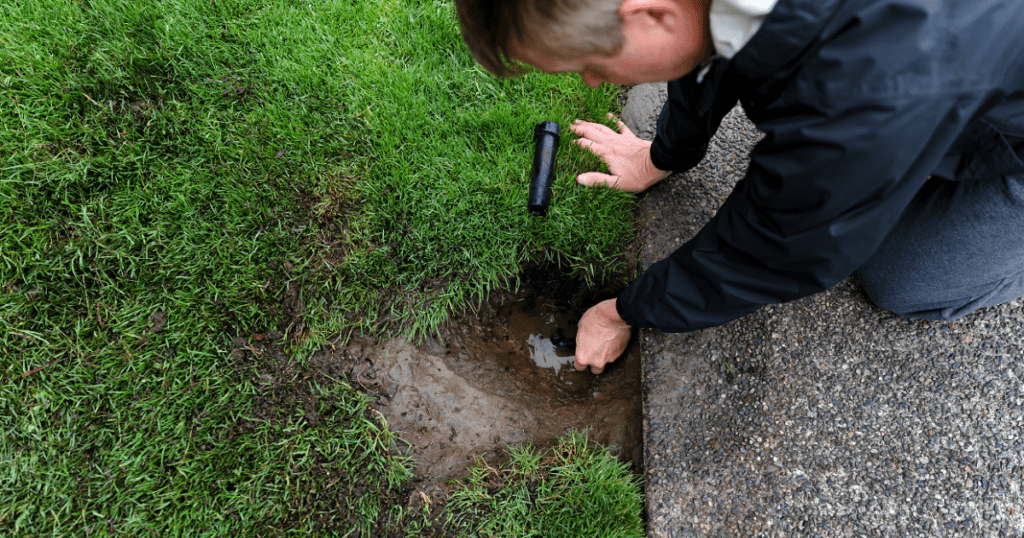
Safety Precautions When Working on Sprinklers
Turning Off Power Sources Before Working on Electrical Components
When working on sprinklers, it is critical to turn off all power sources connected to the system. If you are working with an automatic sprinkler system, make sure you disable the control panel and turn off all valves. Similarly, if there is a sprinkler pump repair required for your system, turn off its power source before attempting any repairs.
It is important to take these precautions since water and electricity are a hazardous combination. Failure to shut down the power could result in electrocution or other serious injuries.
Wearing Protective Gear Such as Gloves and Goggles
Working with sprinklers can be messy and dangerous, so it’s crucial to wear protective gear like gloves and goggles when performing maintenance or repairs. Gloves will protect your hands from cuts or scratches while handling parts like PVC pipes or fittings during drip irrigation repair. Goggles will protect your eyes from debris that can fly up when drilling holes in the ground for new parts during Sprinkler system installation or emergency sprinkler repair.
The Cost of Safety Precautions
Safety should always be a top priority when performing any kind of maintenance work around your property. While it may seem like an extra expense to purchase safety equipment, it’s important to remember that personal injuries due to neglecting safety precautions could end up costing far more medical bills than spending money upfront for appropriate safety gear.
Additional Safety Tips for Sprinkler Maintenance
- If you are not comfortable performing sprinkler repairs yourself, consider hiring a professional service for reliable irrigation repair services.
- Avoid working on your lawn sprinkler system repair during windy conditions, as the wind can blow debris or chemicals into your face or eyes.
- Be aware of the sprinkler system parts that are hot when in use, such as valves or pipes that have been exposed to direct sunlight, and avoid touching them until they have cooled down.
The Importance of Safety with Sprinkler Repair
It cannot be stressed enough how crucial safety is when it comes to sprinkler repairs. Ensuring power sources are off and wearing protective gear can prevent accidents and injuries while performing maintenance on your system. In addition to preventing injuries, taking these precautions can also lead to a more cost-effective solution since you won’t have to deal with damage caused by neglecting safety measures.
Frequently Asked Questions
How do you fix a sprinkler?
To fix a sprinkler, start by identifying the problem, such as a clogged nozzle or a broken head. Clear any debris from the nozzle or replace it if necessary. For broken heads, turn off the water supply, dig around the head, unscrew the broken one, and replace it with a new one. Test the system to ensure proper functionality.
What is the proper maintenance of sprinkler?
Proper maintenance of a sprinkler system includes regular inspection for any leaks, clogs, or misaligned heads. Clean or replace clogged nozzles and adjust misaligned heads as needed. Ensure the system is adequately programmed and that the water pressure and coverage are appropriate. Also, winterize the system by draining any excess water to prevent freezing and damage.
What are the problems of sprinkler system?
Common problems with sprinkler systems include clogged nozzles, leaks in pipes or fittings, misaligned heads, and inadequate coverage. Other issues may arise from electrical problems with the controller or valve malfunctions. Overgrown vegetation can also obstruct the proper operation of sprinklers. Regular maintenance and prompt repairs can address these problems.
What is a fixed spray sprinkler?
A fixed spray sprinkler is a type of sprinkler head that emits water in a fixed pattern and range. It typically has a fixed arc and a specific radius of coverage. These sprinklers are often used in smaller areas or to target specific plants or areas in a garden or landscape.
How do you fix a broken sprinkler head?
To fix a broken sprinkler head, turn off the water supply to the sprinkler system, dig around the broken head to expose the riser, and unscrew the broken head from the riser. Replace it with a new head, ensuring a secure connection, and use a wrench to tighten it if necessary. Finally, turn the water supply back on and test the sprinkler for proper operation.
What causes sprinklers to stop working?
Sprinklers may stop working due to various reasons, such as a broken or clogged sprinkler head, low water pressure, valve failures, electrical issues with the controller, or a damaged pipe. Insufficient maintenance, including neglecting to clear debris or adjust misaligned heads, can also lead to sprinkler malfunctions. Identifying the specific cause is crucial for troubleshooting and repairing the system.

